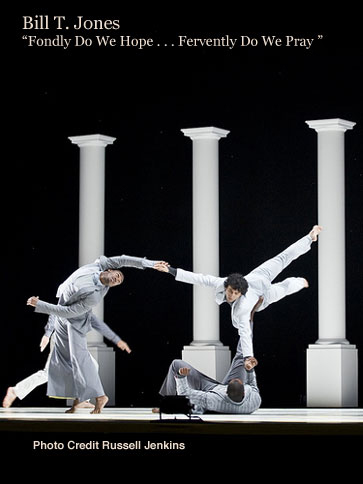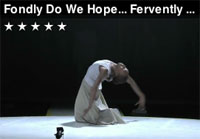 Anticipation can be the harbinger of great disappointment. When we excitedly anticipate that “next great thing” whether it is Scorsese’s next film, Lagerfeld’s next fashion line, or Wolfgang Puck’s next restaurant, the hype can kill the experience before it ever happens. The demanding pedestal of expectation is a tough thing to overcome for any great artist.
Anticipation can be the harbinger of great disappointment. When we excitedly anticipate that “next great thing” whether it is Scorsese’s next film, Lagerfeld’s next fashion line, or Wolfgang Puck’s next restaurant, the hype can kill the experience before it ever happens. The demanding pedestal of expectation is a tough thing to overcome for any great artist.
Bill T. Jones’s latest creation, “Fondly Do We Hope . . . Fervently Do We Pray,” carried with it the burden of high expectations. Mr. Jones is one of the most compelling dance/theater artists making work today, and he is in a period of creativity that is perhaps unmatched by any other in his remarkable career. Recent years have brought us Mr. Jones’s critically acclaimed “Blind Date,” “Chapel/Chapter,” the Tony Award for choreography for “Spring Awakening,” and the equally lauded Off Broadway and now on Broadway, “Fela!” Adding to the expectations surrounding his newest work is Mr. Jones standing with the hip and famous, with mass culture icons such as Tyra Banks frequenting his performances, and magazines like Vanity Fair featuring him.
So as any great artist of a certain age enjoying a great deal of success would do, Mr. Jones took on a safe and uncomplicated project so as not to disturb the comfort of his rising success, right? Wrong. Mr. Jones’s career has frequently been about controversy and risk and has always been about the complex and often uncomfortable. His new work is no different.
“Fondly Do We Hope. . .” was commissioned by the Chicago-area Ravania Festival to honor the 200 th anniversary of Abraham Lincoln’s birth. Lincoln, slavery, civil war, emancipation, 100 years of brutal repression, civil rights, Obama. Now there’s a simple and easy legacy to take on, one that could have disastrous results for even the most accomplished of artists. However, Mr. Jones’s “Fondly. . .” is a gift to us all—in this reviewer’s opinion, a masterwork. In this work Mr. Jones the artist/intellectual/activist has created the rarest of pieces, the intellectually and culturally informed, politically aware work of art whose lasting impression is not its cleverness or righteousness, but instead its sheer beauty. Not beauty in the classical sense but beauty of the deeply considered, beauty of unforgettable imagery, and beauty of a theatrical experience so seamless and fully realized that it becomes more like a rich dream for those experiencing it. When an artist takes the complex and painful and leaves his/her audience with an overwhelming sense of beauty and hope, the artist must be considered a master. Mr. Jones is in that league.
simple and easy legacy to take on, one that could have disastrous results for even the most accomplished of artists. However, Mr. Jones’s “Fondly. . .” is a gift to us all—in this reviewer’s opinion, a masterwork. In this work Mr. Jones the artist/intellectual/activist has created the rarest of pieces, the intellectually and culturally informed, politically aware work of art whose lasting impression is not its cleverness or righteousness, but instead its sheer beauty. Not beauty in the classical sense but beauty of the deeply considered, beauty of unforgettable imagery, and beauty of a theatrical experience so seamless and fully realized that it becomes more like a rich dream for those experiencing it. When an artist takes the complex and painful and leaves his/her audience with an overwhelming sense of beauty and hope, the artist must be considered a master. Mr. Jones is in that league.
In “Fondly . . .” Jones does not attempt to be a historian, but we feel as if we are in Lincoln’s place and time through songs, video imagery, and the words of Lincoln, Frederick Douglas, and Walt Whitman. He does not attempt to tell a linear story, yet his script (co-written with Janet Wong, associate artistic director and video designer for “Fondly. . .”) and use of an on-stage narrator are deeply moving and create vividly descriptive snapshots of Lincoln’s life and the lives of others, including the life of Mr. Jones himself. While there is original music for the piece, there is no full-length commissioned score, but instead an amalgamation of music that brilliantly brings us into the mood, era, and message of any given moment during the work. The choreography and exquisitely expressive and athletic dancers are the dramatic backbone of “Fondly . . . .” However, they would not succeed at the same level without all of the other intelligently directed theatrical elements. In short Mr. Jones does not deal in convention yet has created a multi-dimensional, complex and emotionally effecting work of art that only the most gifted of theatrical directors/creators could achieve.
“Fondly Do We Hope . . . Fervently Do We Pray” could be described as a thoughtful contemplation on the effect that Abraham Lincoln has had on our country, yet it is so much more than that. It is a moving reflection on our national psyche and individual lives. It is Mr. Jones’s expression of the concept of democracy being “by the people for the people” and Lincoln’s inseparable connection to that ideal. It is a powerful yet nuanced comment on the legacy of slavery. It is a beautiful work of dance/theater. It is Mr. Jones’s personal statement about still believing in great men and women . . . cautiously. It is all of those things, and the piece succeeds on so many levels it seems pointless to break it down and analyze. Perhaps we should simply take “Fondly Do We Hope . . . Fervently Do We Pray” as a gift from Mr. Jones to Abraham Lincoln and all of us who embrace the hope of democracy, just as the title and those words were originally a gift of hope from President Lincoln to his country. Brilliantly, this work of art defies easy categorization—just like Bill T. Jones.
Reviewed by Michael Reed
Comments are closed.